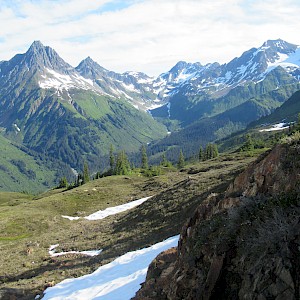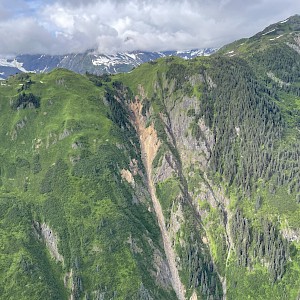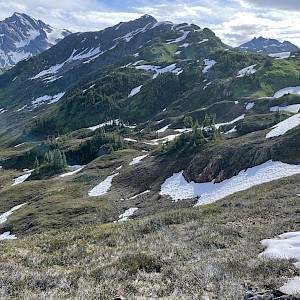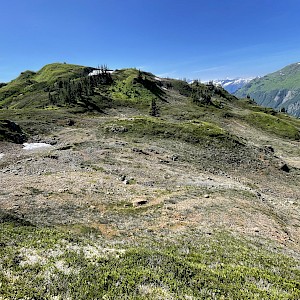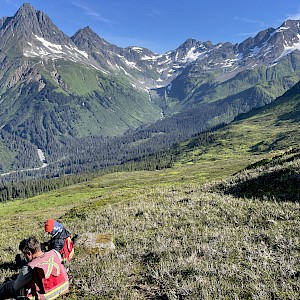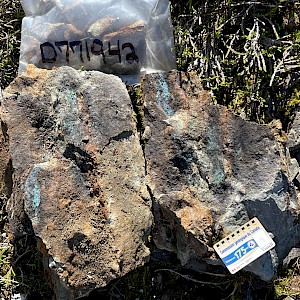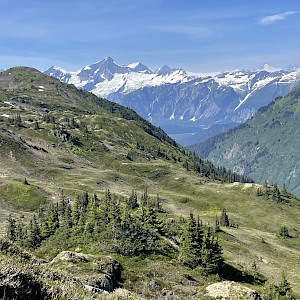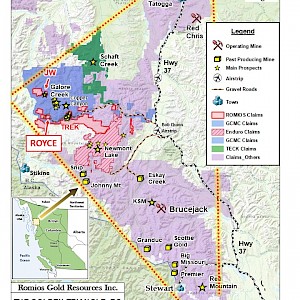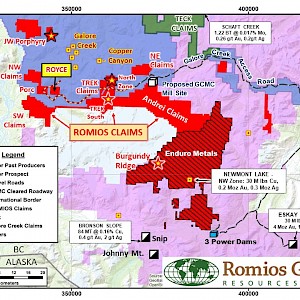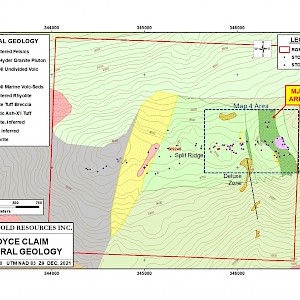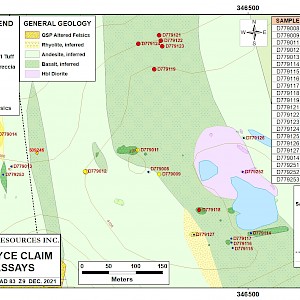Royce Claim
-
Overview
Property Type- Mesothermal, gold-bearing quartz +/- pyrite veins occur at several sites throughout the eastern half of the claims. Past small-scale drill programs do not appear to have tested some of these zones, including a series of gold bearing pyrite-quartz veins and their mineralized host rocks discovered in 2021.
- A prominent quartz-sericite-pyrite gossanous unit (the “Deluxe Zone”) may be due to hydrothermal alteration along a fault zone or an earlier felsic volcanic unit. Several gold-bearing veins are found within this unit.
Size- 616 Hectares
Status- 100% owned with a 1% NSR on any future production owned by the Galore Creek Staking Syndicate.
Exploration Stage
- Current target is a series of auriferous pyritic quartz veins and felsic volcanics that apparently have not been drilled or sampled systematically in the past. Exploration on this target is now at the early stage of systematic outcrop sampling, hand-trenching, and soil sampling to trace the extent of the zone.
- Past localised drill programs, soil sampling, mapping and an airborne Mag-EM survey were largely outside this new zone.
Location
The ROYCE claim is located 9 km southwest of the giant Galore Creek Cu-Au alkalic porphyry deposits and 1.5 km south of the Ann porphyry Cu occurrence (the Royce claim area was originally staked by various companies in response to results of exploration work on the Ann and nearby Paydirt prospects).
-
Geology/Exploration
Highlights Of Key Target Areas
The 2021 exploration resulted in the discovery of a series of quartz-pyrite-chalcopyrite veins up to 35 cm wide as well as quartz flooded felsic volcanics that returned encouraging results up to 1.375% Cu, 1.92 g/t Au and 60.1 g/t Ag. All 5 samples from these poorly exposed, largely overburden covered veins assayed >1 g/t Au. The veins are near the historic MJB showing but appear to be a separate zone that was not intersected by the shallow drilling at MJB. This area is considered potentially more promising than the historic vein showings on the property as this new showing consists of numerous small mineralized veins in auriferous pyritic felsic rocks that offer some size potential as well as grade continuity compared to the discontinuous nature of the narrow historic veins.
PAST WORK: The current claim area was initially explored by Royce Industries Ltd. and Consolidated Goldwest in 1989-1991. Their work led to the discovery of the Jefe Zone, an altered, quartz veined shear zone with sporadic gold mineralization, and the Deluxe Zone, a shear zone affected by intense quartz-sericite-pyrite alteration with variable gold grades up to 10.5 g/t Au and local base metal mineralization. Drilling by Consolidated Goldwest and trenching by both companies returned mixed results which were not followed up until the area was re-staked in 2006 and then acquired by Romios
Romios’ past work on the claim includes a helicopter–borne aeromagnetic and EM survey conducted by Fugro Airborne Surveys over the ROYCE and adjacent PORC claim in 2007 which outlined a large resistivity low on the west side of the ROYCE claim corresponding to a shale and siltstone formation.
Mapping and prospecting programs conducted by Romios in 2011 located weak to modest, erratic mineralization in the vicinity of 2 historic showings: the Jefe vein/shear zone and the Deluxe sericite-pyrite-silica altered shear zone. A sample of the Jefe vein assayed 19.05 g/t Au, 42.5 g/t Ag, and 0.50% Zn, however, other samples proved largely barren. Prospecting also identified a thick quartz vein to the east of the main zone, though it only returned weak anomalous values (0.07 g/t Au, 1.0 g/t Ag and 0.18% Cu).
Silver results from Romios’ mobile-metal-ion soil sampling identified a possible 300 metre northern extension of the Deluxe zone beneath the overburden as well as 2 new targets at the northern corners of the grid. However, the former anomaly is based on a few widely spaced samples; infill sampling at a tighter spacing is required to confirm this trend
A brief mapping and prospecting program in 2019 included geological mapping of the west-central part of the claim and the collection of several samples from veins and shear zones related to the Jefe and Deluxe zones. No significant assay values were returned.
2021: A brief mapping and sampling program was conducted by Romios personnel on the eastern-central part of the claims in order to examine the “Deluxe” QSP (quartz-sericite-pyrite) altered zone and determine its origin and potential, as well as examining a number of historic gold showings in this area. The results of this work suggests that the Deluxe Zone is a pyritic felsic volcanic lens with associated small Cu-Au prospects. This work also resulted in the discovery of a series of Au-Ag-Cu-bearing pyrite-quartz veins up to 35 cm wide located north of the historic MJB showing. These veins and the host pyritic felsic volcanic rocks assayed up to 1.375% Cu, 1.92 g/t Au and 60.1 g/t Ag. All 5 samples from these poorly exposed, largely overburden covered veins assayed >1 g/t Au.
Conclusions
The 2021 program resulted in the discovery of what appears to be an overlooked gold-silver-copper zone comprised of a series of multiple quartz-pyrite-chalcopyrite veins within sheared, pyritic, silicified (?) felsic volcanics. The consistency of the assays among the 5 samples and the presence of gold mineralization within the pyritic felsic host rock itself bodes well for the potential extent and consistency of this mineralization. A basic program of detailed rock sampling, hand-trenching and soil sampling on this grass-covered, open slope should be effective in tracing the mineralized zone.
-
Press Releases
Jul 20, 2018


